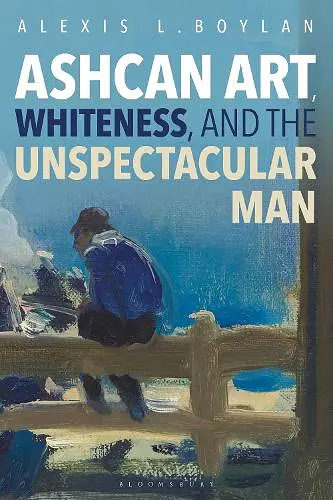Ashcan Art, Whiteness, and the Unspectacular Man
Format:Hardback
Publisher:Bloomsbury Publishing PLC
Published:20th Apr '17
Currently unavailable, and unfortunately no date known when it will be back

This book reframes narratives about whiteness, masculinity, and modernity in turn-of-the–20th-century visual culture by considering how the Ashcan Circle of artists attached new meaning to invisibility, averageness, and the unspectacular male body in their paintings.
Arriving in New York City in the first decade of the twentieth century, six painters—Robert Henri, John Sloan, Everett Shinn, Glackens, George Luks, and George Bellows, subsequently known as the Ashcan Circle—faced a visual culture that depicted the urban man as a diseased body under assault. Ashcan artists countered this narrative, manipulating the bodies of construction workers, tramps, entertainers, and office workers to stand in visual opposition to popular, political, and commercial cultures. They did so by repeatedly positioning white male bodies as having no cleverness, no moral authority, no style, and no particular charisma, crafting with consistency an unspectacular man. This was an attempt, both radical and deeply insidious, to make the white male body stand outside visual systems of knowledge, to resist the disciplining powers of commercial capitalism, and to simply be with no justification or rationale.
Ashcan Art, Whiteness, and the Unspectacular Man maps how Ashcan artists reconfigured urban masculinity for national audiences and reimagined the possibility and privilege of the unremarkable white, male body thus shaping dialogues about modernity, gender, and race that shifted visual culture in the United States.
Ashcan Art, Whiteness, and the Unspectacular Man is an insightful and beautifully written book that offers altogether new ways of understanding the links between gender, race, and art. It is both great art history and a great read. * Martin A. Berger, Professor of History of Art and Visual Culture, University of California, Santa Cruz, USA, and author of Sight Unseen: Whiteness and American Visual Culture *
Ashcan Art, Whiteness, and the Unspectacular Man is compellingly written and grounded in impressively extensive interdisciplinary research. Alexis Boylan has performed a stunning feat of highly original scholarship and analysis that resets the compass of how we understand a group of American artists who have long been central to the history of American art. Her prose is limber, her ideas fresh and original, and she knits together a remarkable array of diverse sources to create a convincing narrative that is simultaneously densely complex and highly readable. The rich texture of her chronicle is a breathtaking high wire act in which through close reading and thick description she confidently lays out her analysis and its conclusions. This will be a volume of great importance to the field of American art history, as well as to the related disciplines of visual culture studies, American studies, literature, history, and film, to name just a few. Boylan’s chronicle about cultural anxieties, ambiguity, and unremarkable men is, well, remarkable, clearly stated, and convincingly argued. * Betsy Fahlman, Professor of Art History, Arizona State University, USA *
In recent decades, groundbreaking work in American studies and art history has tackled a vital question: How has white manhood been constructed as a universal norm? Alexis Boylan joins Gail Bederman, Martin Berger, and Richard Dyer in positing an answer. Hers focuses on the paintings of the Ashcan School and relies on sharp visual analyses and innovative readings of the historical record. Boylan's book presents new ways of approaching this important artistic movement, and with it the popular fantasies of race, gender, and class that Ashcan artists experienced at the turn of the twentieth century. It also equips readers with tools to critique American discourses on immigration, then and now. It’s hard to think of a more timely art-historical project. * Tanya Sheehan, William R. Kenan, Jr. Associate Professor and Chair, Colby College, USA *
Alexis Boylan’s book is a revelation that reconceives the importance of Ashcan artists as keen observers of, and commentators on, the cultural changes of their time. These painters are justly celebrated for capturing the spectacular city, showing how modern work, consumption, entertainment and transportation transformed human interactions linking seeing and being seen to modern notions of self and social position. Boylan’s careful analysis of pictures demonstrates that beyond mere documentation, Ashcan works present carefully-edited visions of New York from the perspective of a white male subject that delimit the power, or even the presence, of women, immigrants and racial others. In so doing, Ashcan painters presented a unique investigation of the meanings of modernity, whiteness and masculinity that reveal both the advantages and the anxieties that came with race, gender and class privilege. Deftly weaving together insights from cultural critics and historians as well as scholars of visual culture, Boylan argues that Ashcan school painting works against both conservative and radical concepts of masculine authority at the time, exposing the frustrations and failures they felt operating outside the controlling gaze of commercial capitalism even as they experienced the power such a position offered. The value of Boylan’s investigation of the white male desire to be truly seen while avoiding objectification goes beyond enriching our understanding of history, it offers much food for thought in understanding how whiteness can continue to produce feelings of fragility that impede movement toward equity and inclusion. * Elizabeth Hutchinson, Associate Professor of American Art History, Barnard College/Columbia University, USA *
Well-written and full of close readings, the text is founded on significant primary research ... A worthwhile addition to literature on American urban realism. * The Burlington Magazine *
ISBN: 9781501325755
Dimensions: unknown
Weight: 590g
280 pages